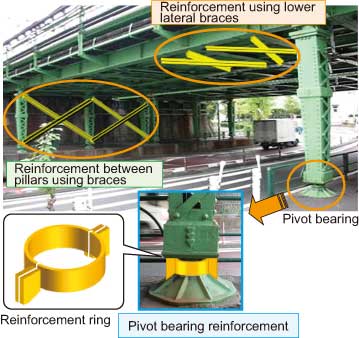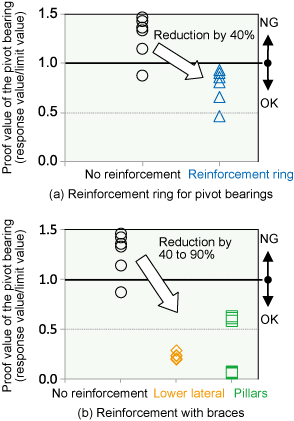9. An aseismic evaluation technique and reinforcement methods for old-type steel structures with pivot bearings
- The RTRI developed an aseismic evaluation technique for old-type steel structures with pivot bearings which are often found in cities.
- It also proposed a method to reinforce girders and pillars with pivot bearings and clarified the effects of such reinforcement against a large-scale earthquake.
Many old-type steel structures in cities are in key locations, i.e. crossing points with main roads and it is important to evaluate their level of safety in response to earthquakes and improve their aseismic capacity. However, this is difficult given the complexity and variety of such structures.
Many pivot bearings (steel bearings combining a spherical protrusion and a concave element) are used in these structures, and may represent weak points in the case of large-scale earthquakes. Accordingly, RTRI performed pivot bearing load tests using parts removed from an actual bridge and proposed a technique for evaluating strength of resistance and deformation performance based on the test results. RTRI then introduced this technique into non-linear frame analysis models of structures, and developed a method for evaluating the aseismic performance of structures by means of earthquake response analysis. As a result, it became possible to evaluate aseismic performance in response to large-scale earthquake conditions. This evaluation technique has already been applied to aseismic evaluation of actual bridges, as well as for the assessment of reinforcement work.
RTRI also devised a compact reinforcement ring that can be easily applied to works as a technique for aseismic reinforcement of pivot bearings (Fig. 1 (1)). Through load testing and analysis, it was confirmed that the proof value (response value/limit value) during large-scale earthquakes is reduced by about 40% (Fig. 2 (a)) as a result of its application. As reinforcement techniques to further improve aseismic performance, RTRI developed a method to reinforce girders using lower lateral braces (Fig. 1 (2)) and a method to reinforce the spans between pillars using braces (Fig. 1 (3)). It was confirmed that the proof value during large-scale earthquakes was reduced by about 40 to 90% (Fig. 2 (b)) as a result of their application.
 Fig. 1 Various reinforcement methods for old-type steel structures
Fig. 1 Various reinforcement methods for old-type steel structures Fig. 2 Examples of evaluation for various reinforcement methods
Fig. 2 Examples of evaluation for various reinforcement methods